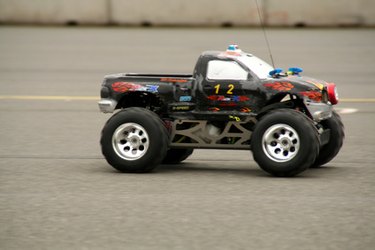Things You'll Need
Screwdriver
Pliers
RC car kit
Hobby knife
Hardware trays
Sandpaper
Paint
Nitro engine
Thread lock
Soap
Calipers
Grease
WD-40

When most people attempt to build a RC car, they reach for an electrical model since they're easier to build. However, for those well-versed in the art of RC car construction, it might be beneficial to attempt to build a nitro or gas-powered RC car. While definitely a bigger challenge, nitro RC cars pack more power, can go faster, and offer an impressive display when blasting out of the gate.
Step 1
Purchase the materials for your nitro engine, either "ABC" type or "ABN." The "ABC" type nitro stands for Aluminum Brass Chrome. In this configuration, the piston is made of aluminum, the cylinder is brass and the internal plating of the cylinder is chrome. The "ABC" is the standard bearer on the field, known for its lightweight, good price and long life due to the chrome plating. The "ABN" nitro stands for Aluminum Brass Nickel. This is almost a mirror of the "ABC" type, where nickel takes the place of the chrome. The main benefit to this type is price only. The nickel plating wears down fast and will require a replacement often compared to the chrome. Keep this in mind when buying supplies.
Video of the Day
Step 2
Assemble your nitro car kit. Read over your manual fully once. Make note of all screw sizes and types and organize them in small bowls or hardware trays to help keep track of them. When working on screwing parts down, take extra care not to overtighten or force them, as stripping of the threads can occur. Rub the threads of your screws along a bar of soap to help with tight fits and to prevent stripping. When screwing together metal components or nuts, use liquid thread lock. This will prevent them from loosening over long runs and heavy vibration from the nitro engine.
Step 3
Take extra care and time when fitting parts that require accurate size or length. Use calipers to make your measurements. Mark the cut and check the measurement again before cutting. Fit the parts in place before securing them. Sand down edges until they fit perfectly. Secure in place once you're sure of the fit.
Step 4
Grease all moving parts, making sure to coat anything that swings, pivots, spins or turns. If grease gunks up the gears too much, a light oil based lubricant like WD-40 will work. The light lubricant will allow for smooth running parts and will not build up over time like grease.
Step 5
Put together your receiver box as your manual describes. Adjust the placement of the receiver box and try to find a spot that is away from any moving or hot parts, particularly the nitro engine. Moving and hot parts can cause interference between the receiver and remote resulting in glitching and poor performance. Add insulation to your receiver box by filling it with foam.
Step 6
Design the paint job you want for your nitro RC car. Whether you want flames with flowers, sharp racing stripes or skulls, anything can be done. However, doing it right takes some time. Detail on paper what you want to do. Making templates and color directions to refer to later will save time. Wash all parts that will be painted with warm soapy water removing any dirt or oil that could cause the paint to chip or peel. Use painter's tape to make sharp clean lines. Finish the paint job with a clear glossy or matte varnish to protect the paint job from the elements and any bang ups on the track.
Step 7
Assemble all finished components together. Attach these components to the chassis. Make sure every thing fits well. Ensure all parts are snug to the chassis, as over time, vibration can loosen and damage parts. Attach the body to the chassis, again ensuring a tight fit. Attach any external details and spoilers to the body.
Step 8
Take outside to a test track or flat stretch of road. Fill up your nitro engine with fuel and perform a few test runs. Make sure everything is moving smoothly and correctly. Get a feel for how the nitro RC car handles and drives. Once you're happy with its performance, drain the fuel and give the car a fast clean before storing it for your next big race.
Tip
Decide on the type of nitro RC car kit you would like to build. Nitro motors come in two different types, the 2-stroke or the 4-stroke. The 2-stoke produces higher RPMs and requires a fuel and oil mix, where the 4-stroke has its advantages in off rode driving and runs off of straight fuel. Decide on the kit that best fits you and your skill level. Gather all the tools you will need and keep organized with the parts for your kit. Keeping your kit parts and tools organized will help keep things maintained and help building move faster. Finish this by sanding all rough edges and notches of the plastic parts and body.
Video of the Day